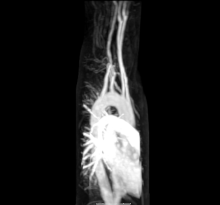Aberrant subclavian artery
| Aberrant subclavian artery | |
|---|---|
| Classification and external resources | |

Normal anatomical locations of right and leftsubclavian arteries
| |
| ICD-10 | Q27.8 |
| ICD-9 | 747.21 |
Aberrant subclavian artery, or aberrant subclavian artery syndrome, refers to a rareanatomical variant of the origin of the right or left subclavian artery. This abnormality is the most common congenital vascular anomaly of the aortic arch.
Presentation
The aberrant artery usually arises just distal to the left subclavian artery and crosses in the posterior part of the mediastinum usually behind the oesophagus on its way to the rightupper extremity. Such course of this aberrant vessel may cause a vascular ring around the trachea and oesophagus. Dysphagia due to an aberrant right subclavian artery is termeddysphagia lusoria. Palsy of the recurrent laryngeal nerve is termed Ortner's syndrome.
The aberrant right subclavian artery frequently arises from a dilated segment of the proximal descending aorta, the so-called Diverticulum of Kommerell. It is alternatively known aslusorian artery.
Treatment
Surgery is sometimes used to treat the condition.[1]



No comments:
Post a Comment